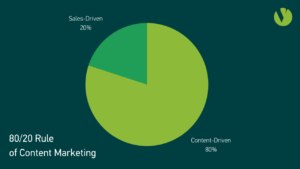If your brand is any way invested in marketing, you’ll likely have at least come across the phrase ‘Content is King’ – a staple motto within the realm of Content Marketing.
So, why is it said that ‘Content is King’? Engaging in Content Marketing can deliver resounding success in that it builds brand awareness, drives engagement from audiences and provides the foundation for driving acquisitions.
We’re all aware of the exponential growth surge in Netflix’s user base at the beginning of the pandemic as worldwide circumstances intensified consumers’ insatiable hunger for content.
While your average brand can’t possibly compete with the entertainment value of a binge-worthy TV series – there’s no disputing that in the digital marketing space, content is currency.
As we discussed in our 10 Digital Marketing Trends for 2022, if your brand’s not got a content strategy, the chances are your competitor has. So, let’s delve a little deeper into what Content Marketing entails.
Content Marketing
When it comes to social media, or indeed any form of content, an overemphasis on the promotion of products and services is oftentimes where organisation’s fall short in their content marketing efforts.
For many organisations, it can be difficult to understand the connection between making money and creating content. From the outset, it might even appear to be a waste of resources. But it’s part of a crucial long game.
While the value of your target customers is clear to you, your value to them is not so clear. This is why putting out nothing but sales-oriented messaging rushes your marketing funnel along – ultimately collapsing it.
This approach wrongly assumes that your target customers trust your brand and identify with it enough to want to make an acquisition. This is not necessarily the case, contrary to belief.
Content marketing plays a vital role in building social proof, establishing credibility and demonstrating thought leadership – all very important considerations in the customer journey.
What Makes Good Content?
Whether it’s utilising Google’s search engine to answer their everyday questions, or browsing their Instagram feeds for something that interests them, the average person spends more than six hours online each day.
That’s a lot of time, creating opportunities for brands to be a part of their content consumption. But your brand is one content source of an infinite number of content providers, competing for your target audience’s attention.
Speaking of attention – it’s waning, so the art of the edit is important. Brands, therefore, are realising that little room remains for self-serving, lavish praise – and the focus should firmly remain on what’s in it for the consumer.
In this oversaturated marketing arena, planning and strategy becomes your brand’s most important asset, and real thought should be placed on the objectives of your content and how you will achieve them.
Generally speaking, your content should get across a balanced mixture of the following attributes and appeals:
1. Entertaining
When applicable, the use of content that entertains is something that connects with audiences on a very basic, human-to-human level, personifying your brand and making it easier for your consumers to identify with it.
This content does not need to relate directly to your products and services per sé, once it does still relate with and appeal to your target audiences. The ‘just like you‘ effect is a very under-utilised trust builder.
2. Informational
Verging on the rational versus the emotional, this type of content gives your brand the opportunity to demonstrate its competencies in its area of expertise, positioning it as a thought leader and trusted provider or seller.
Informational (or Educational) content doesn’t necessarily have to relate to your brand or its offering – it could take a broader view, perhaps of current affairs, industry-relevant news or anything else of interest to audiences.
3. Inspirational
As humans, we are nothing if not aspirational. Consumers are much more inclined to take a desired action if they feel inspired by what they consume. Can your offering change their life? Prove it.
Inspiring consumers can be done by means in a myriad of ways – whether it be a high-production video series, or case studies and customer testimonials.
4. Engaging
The best way to have your target audiences to involve themselves with your brand is… to involve them! Starting a conversation with our consumers means inviting their experiences, thoughts and ideas.
Engaged audiences are much more likely to convert and potentially even become brand advocates, sharing their experience of your brand with others.
What’s the 80/20 Rule in Content Marketing?
On the basis of the above, by ensuring a balance between sales-driven marketing and content-driven marketing, it’s a good rule of thumb to apply the 80/20 rule.
The 80/20 rule, otherwise known as the Pareto Principle, is often applied to natural phenomena as an optimal ratio. A related example is the idea that ‘80% of business comes from 20% of our clients’.
In the case of content marketing, 80% of digital marketing content should be content-driven, while the remaining 20% of content is sales driven. This is a good guiding principle to retain audience engagement.
Essentially, 80% of posts should provide real value to your audience (i.e. it entertains, informs, inspires or engages) while the remainder is allocated for explicit promotion fo your brand.
Why is this? Let’s think – as humans, we most often delve into our internet devices at key intervals when we want to escape, find out information, or to simply cure our boredom. Being advertised to is the last thing on our minds.
80/20 Rule Content Marketing Ideas
The sky is the limit when it comes to content-driven posts. What’s more is that what you post can be curated from a third party source, original or even a hybrid of the two. A mixture of all three might even be best.
Browsing third party content could provide opportunities to share timely or newsworthy content – whether that be industry news or even some positive local news stories.
In terms of original content, maybe there is a way for your brand to demonstrate thought leadership by providing a commentary/discussion of something that is topical within the industry you are operating in, ‘How-Tos’ etc.
The remaining 20% will then focus on your audiences completing a call-to-action. Does your brand have positive media coverage? Are you running a limited special offer? Maybe there are some testimonials you can share.
We must always consider the sustainability of our content and social media strategies. Content should consistently reflect what our audiences want to see so as to grow and retain brand following and engagement.
Now that you have read this Content Marketing & 80/20 Rule blog, why not see our other articles for more web development, graphic design and digital marketing insights?
Do you need help with your Digital Marketing strategy? Contact us today to get your project started.



